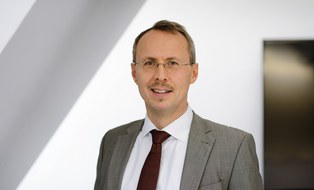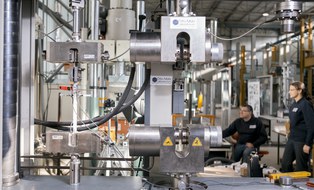PROFILE OF THE CHAIR OF STEEL CONSTRUCTION
Table of contents
History
Author: Klaus Beyer
The Chair of Steel Construction was established in the oldest faculty of the Dresden University of Technology, whose cradle was in the former "school of engineers" (for fortification builders), which was extended to the "Bau- und Industrieschule" in 1814. On 01.05.1828 the "Polytechnische Bildungsanstalt" was established (origin of today's Technical University), into which the construction and industry school was integrated.
Emil Winkler was the first to teach the newly established field of "Iron Bridge Design" in 1863. He was followed in 1869 by Wilhelm Fränkel, who had studied in Dresden and had been assistant to Andreas Schubert. After 28 years of successful teaching of Fränkel, Georg Christoph Mehrten succeeded him in the field of "Iron Bridges" and took over the teaching positions "Statics of Building Constructions" and "Strength of Materials". In the period around the turn of the century at 1900 which was important for the development of iron constructions, a new professorship was founded. Max Förster was appointed professor and taught the subject "Iron Building Construction" for the first time. With the end of the work of Mehrtens in 1913, Willy Gehler who later also led the newly founded Material Testing Office took over the professorship with the fields "Statics of Building Constructions", "Strength of Steel" and "Steel Bridge Design".
The abundance of tasks led to the founding of a chair for the subject "Technical Mechanics" in 1919, which was also assigned to the subjects "Statics of Building Constructions" and "Strength of Materials". Kurt Beyer, who also taught the subject "Movable bridges", was appointed to this chair. Kurt Beyer had studied and promoted in Dresden and had been an assistant to Mehrtens. After the death of Max Förster in 1930, Beyer took over the field of "Steel Buildung Construction", which also included tank and mast construction. Beyer has expanded the range of subjects with the "Hydraulic Steelwork" and the "Steel Construction for the large-scale brown coal opencast mining construction machines".
After the departure of Gehler in 1945, Beyer also took over his tasks. For the first time, all areas of steel construction were represented by a chair, as is still the case today.
After the death of Kurt Beyer a division of his chair took place. The fields of steel construction (together with the statics of building constructions) were taken over from 1953 to 1971 by Professor Gustav Bürgermeister. After his retirement, Professor Walther Hoyer, who had studied in Dresden, was appointed to the Chair of Steel Construction with the fields of "Basics of Steel Construction" (including welding), "Stability of Steel Structures", "Steel Building Construction", "Steel Bridge Construction", "Hydraulic Steelwork" and "Steel Construction in Conveying Technology". The latter field was represented by him as early as 1962 beside the subjects "Technical Mechanics" and "Dynamics of Structures" until 1971. The successor of Professor Hoyer was Professor Manfred Koch, in whose term of office the reunification of Germany in 1989 took place, which was a great challenge for him as an honest personality.
After the sudden death of Professor Koch in October 1992, his senior assistant, Dr.-Ing. Hans-Dieter Haim temporary became the head of the Chair of Steel Construction. In 1993 he was appointed professor for the field of "Steel Construction in Conveying Technology". Also in 1993, Prof. Dr.-Ing. Wolfgang Graße, was appointed head of the Chair of Steel Construction.
With the retirement of Prof. Haim after the winter semester 2003 this position was not occupied again. Prof. Graße was retired after the summer semester 2004. At first no successor could be called. In the summer semester 2005, Dr.-Ing. Natalie Stranghöner took over the administration of the chair with great commitment in order to continue lectures.
In a second appeal procedure, Dr.-Ing. Richard Stroetmann, an excellent specialist of theoretical and practical structural steel construction, became the new professor for steel construction. From January 1, 2005, he took over the management of the Chair of Steel Construction, continuing the great tradition of the steel construction department at the Faculty of Civil Engineering at the Technical University Dresden.
Services
Contact Person
 © KREBS+KIEFER
© KREBS+KIEFER
Head of the Chair
NameUniv.-Prof. Dr.-Ing. Richard Stroetmann
Send encrypted email via the SecureMail portal (for TUD external users only).
Institute of Steel and Timber Construction, Chair of Steel Construction
Institute of Steel and Timber Construction, Chair of Steel Construction
Visiting address:
Beyer-Bau, Room 06-32 George-Bähr-Straße 1
01069 Dresden
Engineering Services - Fields of Work
- Product development
- Test execution for components, structures and machines
- Damage analysis and assessment
- Construction measurement
- Structural monitoring
- Efficiency studies
- Appraisals
Available testing machines and equipment
Testing machines and equipment
- Electromotive testing machine for tension and compression
- Hydropuls testing machine
- Tensile testing machine for ropes, cables and chains
- Pulsator and steering for dynamic loading
- Large strong floor
- Small strong floor
- Compression testing machines with different capacities
- Triaxial testing machine
- Pendulum impact tester
- Small-scale devices
Testing facilities of the Faculty of Civil Engineering
Otto - Mohr - Laboratorium (OML)
 © Jörg Singer
© Jörg Singer
Technische Universität Dresden – Institute of Concrete Structures – Otto Mohr Laboratory
Send encrypted email via the SecureMail portal (for TUD external users only).
Visiting address:
Otto-Mohr-Laboratorium Zellescher Weg 22a
01217 Dresden
Postal address:
TUD Dresden University of Technology Otto Mohr Laboratory Zellescher Weg 22a
01217 Dresden
